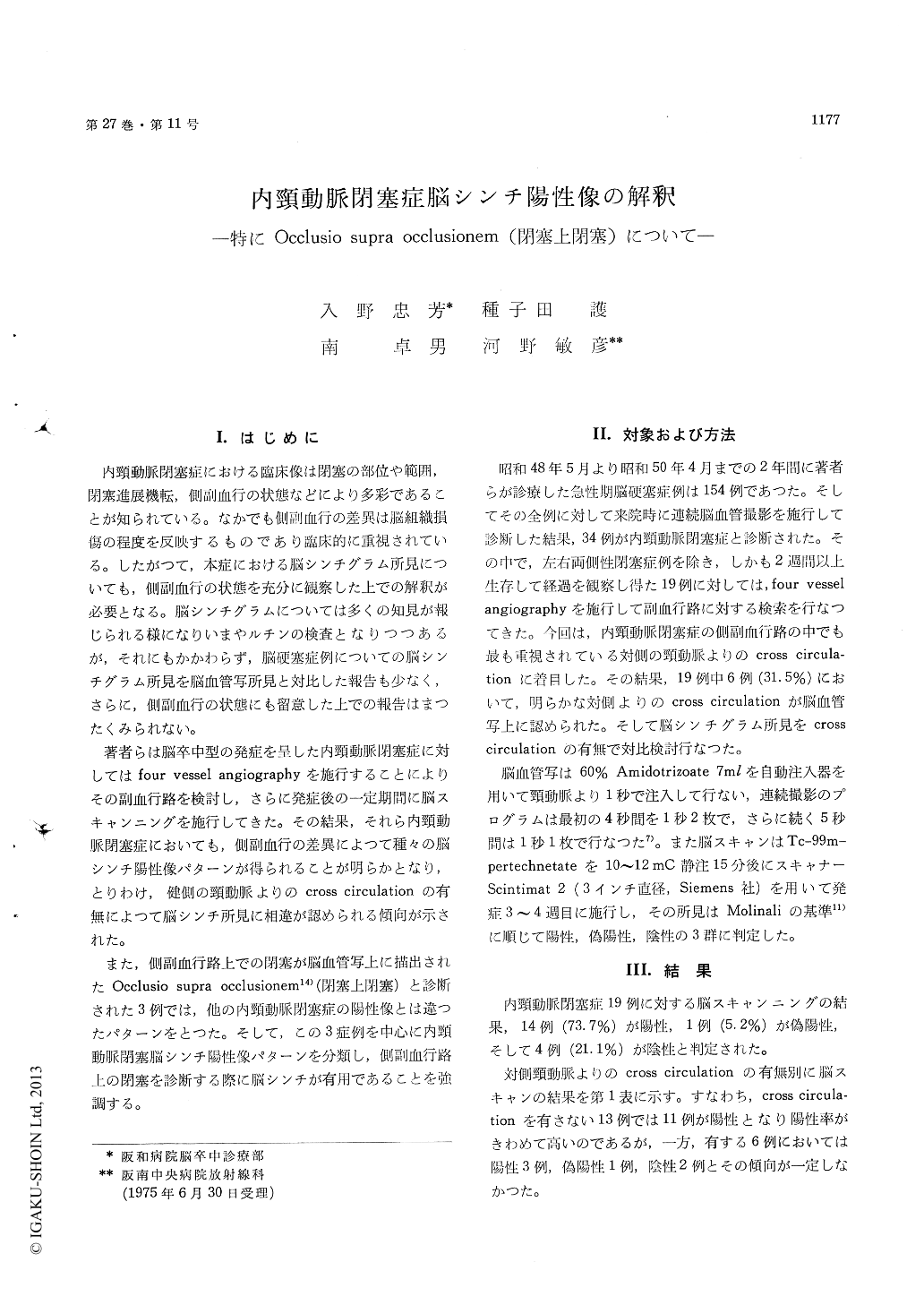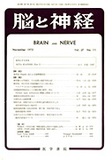Japanese
English
- 有料閲覧
- Abstract 文献概要
- 1ページ目 Look Inside
I.はじめに
内頸動脈閉塞症における臨床像は閉塞の部位や範囲,閉塞進展機転,側副血行の状態などにより多彩であることが知られている。なかでも側副血行の差異は脳組織損傷の程度を反映するものであり臨床的に重視されている。したがつて,本症における脳シンチグラム所見についても,側副血行の状態を充分に観察した上での解釈が必要となる。脳シンチグラムについては多くの知見が報じられる様になりいまやルチンの検査となりつつあるが,それにもかかわらず,脳硬塞症例についての脳シンチグラム所見を脳血管写所見と対比した報告も少なく,さらに,側副血行の状態にも留意した上での報告はまつたくみられない。
著者らは脳卒中型の発症を呈した内頸動脈閉塞症に対してはfour vessel angiographyを施行することによりその副血行路を検討し,さらに発症後の一定期間に脳スキャンニングを施行してきた。その結果,それら内頸動脈閉塞症においても,側副血行の差異によつて種々の脳シンチ陽性像パターンが得られることが明らかとなり,とりわけ,健側の頸動脈よりのcross circulationの有無によつて脳シンチ所見に相違が認められる傾向が示された。
Cerebrovascular occlusive diseases presents variouskinds of brain-scanning results as well as theirclinical symptomes. It has been generally explainedby the participation of collateral circulation in theinfarcted area. In our experienc based on thescanning results obtained in 75 infarcted patientswho were diagnosed following both physical andangiographical findings, the scintigrams sometimesfailed to show positive scans even in the patientswith major cerebral arterial occlusion such as theinternal carotid of the middle cerebral arterial axisocclusion. Therefore, for the more correct compre-hension of the scanning results it is the most im-portant matter to investigate the developement ofcollateral circulation. In our present study, nineteenpatients with the internal carotid artery occlusionunder went bilateral carotid arteriographies toinspect the cross circulation from the opposite non-occluded carotid artery via the anterior communi-cating artery. And the scanning results obtainedafter 3 or 4 weeks after onset were comparedbetween two groups, 6 cases with and 13 caseswithout cross circulation demonstrated by the contralateral angiography.
As a result, among all of 19 patients with theinternal carotid arterial occlusion, 14 cases (73.7%)were diagnosed as positive, 1 case (5.2%) equivocaland 4 cases (21.1%) negative scans. Concerningthe presence of cross circulation, 11 cases among13 cases with it and 3 cases without showed positivescans on the scintigrams. Thus the tendency ofthe positive scans was apparently high in the groupof cross circulation, however, such tendency wasnot demonstrated in the group of no cross cir-culation. All of the three cases showing positiveuptakes of radioisotopes were demonstrated thecombined occlusion of the middle cerebral arterybranch opacified through ocllateral circulation. Con-cerning the shape of theopositive scans, three caseswith duplicated arterial occlusion did not show anoval shaped pattern as seen ordinally in caseswithout cross circulation, but the figures obtainedin such cases were rather irregular.
The combined occlusion of the intracranial smallbranches of the middle cerebral artery and thecarotid artery was already reported by Ring, wherethe intracranial branches were opacified throughcollateral circulation. And Ring used the term"Occlusio supra occlusionem" for these cases show-ing duplicating occlusion on intra- and extra-cranialarterial occlusion. The lateral view of one of ourthree cases diagnosed as occlusio supra occlusionemsimulated that documented by Ring, and the othertwo cases were recognized their middle cerebralarterial branch occlusion on the anteroposteriorview obtained by the contralateral carotid angio-graphy.
The occlusion of the collateral circulation is rarelydemontrated angiographically because of poor fillingof the contrast medium into the circulation asenough as opacifying the small branch of the intra-cranial arteries. This is one of the factors limitingthe diagnostic value of cerebral angiography. Onthe other hand, brain scans which reflect the ische-mic damage whichever with or without angio-graphically demonstrated arterial occlusion, can besupposed to indicate the presence of combinedarterial occlusion demonstrating positive scans ofunusual shape.

Copyright © 1975, Igaku-Shoin Ltd. All rights reserved.


